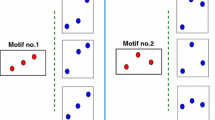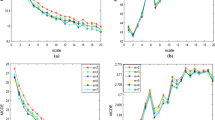Abstract
Entropy has been an important tool for the complexity analysis of time series from various fields. Based on studying all the template mismatches, a modified sample entropy (SE) method, named as inverse sample entropy (ISE), for investigating the complexity of financial time series is proposed in this paper. Different from SE, ISE considers the far neighbors of templates; it also provides more comprehensive information combined with SE. Stock markets usually fluctuate with the economy policies; ISE allows us to detect the financial crisis by the change of complexity. By experiments on both simulated data and real-world stock data, ISE shows that the threshold \(r\) is more flexible compared with that of SE, which allows ISE to be applied not only to limited type of data. Besides, it is more robust to high dimension \(m\), so ISE can be extended to the application of high dimension analysis. For studying the impact of embedding dimension \(m\) under multiple scales on both artificial and real-world data, we made a comparison on the use of SE and ISE. Both SE and ISE are able to distinguish time series with different features and characteristics. While SE is sensitive to high dimension analysis, ISE shows robustness.













Similar content being viewed by others
Notes
Data source at https://finance.yahoo.com/world-indices.
References
Fincke, U., Pohst, M.: Improved methods for calculating vectors of short length in a lattice, including a complexity analysis. Math. Comput. 44(170), 463–471 (1985)
Bhattacharya, J.: Complexity analysis of spontaneous EEG. Acta Neurobiol. Exp. 60(4), 495–502 (2000)
Pincus, S.M.: Approximate entropy as a measure of system complexity. Proc. Natl. Acad. Sci. USA 88, 2297–2301 (1991)
Piqueira, J.R., Mortoza, L.P.: Complexity analysis research of financial and economic system under the condition of three parameters’ change circumstances. Commun. Nonlinear Sci. Numer. Simul. 17(4), 1690–1695 (2012)
Costa, M., Goldberger, A.L., Peng, C.K.: Multiscale entropy analysis of complex physiologic time series. Phys. Rev. Lett. 89, 068102 (2002)
Goldberger, A.L., Peng, C.K., Lipsitz, L.A.: What is physiologic complexity and how does it change with aging and disease. Neurobiol. Aging 23(1), 23–26 (2002)
Ahmed, M.U., Mandic, D.P.: Multivariate multiscale entropy: a tool for complexity analysis of multichannel data. Phys. Rev. E 84(6), 061918 (2011)
Pincus, S.M.: Assessing serial irregularity and its implications for health. Ann. NY Acad. Sci. 954(1), 245–267 (2001)
Johnson, N.F., Jefferies, P., Hui, P.M.: Financial Market Complexity. OUP Catalogue (2003)
Xu, K., Wang, J.: Nonlinear multiscale coupling analysis of financial time series based on composite complexity synchronization. Nonlinear Dyn. 86(1), 441–458 (2016)
Bandt, C., Pompe, B.: Permutation entropy: a natural complexity measure for time series. Phys. Rev. Lett. 88, 174102 (2002)
Truebner, S., Cygankiewicz, I., Schroeder, R., Baumert, M., Vallverdu, M., Caminal, P., Vazquez, R.: Compression entropy contributes to risk stratification in patients with cardiomyopathy. Biomed. Tech. 51(2), 77–82 (2006)
Li, P., Liu, C., Li, K., Zheng, D., Liu, C., Hou, Y.: Assessing the complexity of short-term heartbeat interval series by distribution entropy. Med. Biol. Eng. Comput. 53(1), 77–87 (2015)
Vicente, R., Wibral, M., Lindner, M., Pipa, G.: Transfer entropy: a model-free measure of effective connectivity for the neurosciences. J. Comput. Neurosci. 30, 45–67 (2011)
Zunino, L., Zanin, M., Tabak, B.M., Pérez, D.G., Rosso, O.A.: Complexity-entropy causality plane: a useful approach to quantify the stock market inefficiency. Phys. A 389(9), 1891–1901 (2010)
Franca, L.F., Savi, M.A.: Distinguishing periodic and chaotic time series obtained from an experimental nonlinear pendulum. Nonlinear Dyn. 26(3), 255–273 (2001)
Vlahogianni, E.I., Karlaftis, M.G.: Comparing traffic flow time-series under fine and adverse weather conditions using recurrence-based complexity measures. Nonlinear Dyn. 69(4), 1949–1963 (2012)
Altan, A., Seçkin, K., Stelios, B.: Digital currency forecasting with chaotic meta-heuristic bio-inspired signal processing techniques. Chaos 126, 325–336 (2019)
Richman, J.S., Moorman, J.R.: Physiological time-series analysis using approximate entropy and sample entropy. Am. J. Physiol. Heart Circ. Physiol. 278(6), H2039–H2049 (2000)
Benettin, G., Galgani, L., Strelcyn, J.M.: Kolmogorov entropy and numerical experiments. Phys. Rev. A 14(6), 2338 (1976)
Wu, X., Wang, K., Wang, X., Kan, H.: Lossless chaotic color image cryptosystem based on DNA encryption and entropy. Nonlinear Dyn. 90(2), 855–875 (2017)
Udhayakumar, R.K., Karmakar, C., Palaniswami, M.: Approximate entropy profile: a novel approach to comprehend irregularity of short-term HRV signal. Nonlinear Dyn. 88(2), 823–837 (2017)
Lopes, A.M., Machado, J.T.: Integer and fractional-order entropy analysis of earthquake data series. Nonlinear Dyn. 84(1), 79–90 (2016)
Ezekiel, M.: Methods of Correlation Analysis (1930)
Ezekiel, M., Fox, K.A.: Methods of Correlation and Regression Analysis: Linear and Curvilinear (1959)
Azaria, M., Hertz, D.: Time delay estimation by generalized cross correlation methods. IEEE Trans. Signal Process 32(2), 280–285 (1984)
Pesin, Y.B.: Characteristic Lyapunov exponents and smooth ergodic theory. Uspekhi Matematicheskikh Nauk 32(4), 55–112 (1977)
Müller, P.C.: Calculation of Lyapunov exponents for dynamic systems with discontinuities. Chaos Soliton Fract. 5(9), 1671–1681 (1995)
Barnston, A.G., Ropelewski, C.F.: Prediction of ENSO episodes using canonical correlation analysis. J. Clim. 5(11), 1316–1345 (1992)
Kwon, Y.K., Choi, S.S., Moon, B.R.: Stock prediction based on financial correlation. In: Proceedings of the 7th Annual Conference on Genetic and Evolutionary Computation, pp. 2061–2066 (2005)
Carpi, L.C., Saco, P.M., Rosso, O.A.: Missing ordinal patterns in correlated noises. Phys. A 389(10), 2020–2029 (2010)
Kulp, C.W., Zunino, L., Osborne, T., Zawadzki, B.: Using missing ordinal patterns to detect nonlinearity in time series data. Phys. Rev. E 96(2), 022218 (2017)
Kennel, M.B., Brown, R., Abarbanel, H.D.: Determining embedding dimension for phase-space reconstruction using a geometrical construction. Phys. Rev. A 45(6), 3403 (1992)
Kulp, C.W., Zunino, L.: Discriminating chaotic and stochastic dynamics through the permutation spectrum test. Chaos 24(3), 033116 (2014)
Liu, Q., Wei, Q., Fan, S.Z., Lu, C.W., Lin, T.Y., Abbod, M.F., Shieh, J.S.: Adaptive computation of multiscale entropy and its application in EEG signals for monitoring depth of anesthesia during surgery. Entropy 14(6), 978–992 (2012)
Sander E, Yorke JA. Period-doubling cascades galore. arXiv preprint. arXiv:0903.3613 (2009)
Wu, G.C., Dumitru, B.: Discrete fractional logistic map and its chaos. Nonlinear Dyn. 75, 1–2 (2014)
Acknowledgements
The financial supports from the funds of the National Natural Science Foundation of China (61771035) and the Fundamental Research Funds for the Central Universities (2018JBZ104, 2019YJS194) are gratefully acknowledged.
Author information
Authors and Affiliations
Corresponding author
Ethics declarations
Conflict of interest
The authors declare that they have no conflict of interest.
Additional information
Publisher's Note
Springer Nature remains neutral with regard to jurisdictional claims in published maps and institutional affiliations.
Appendix
Appendix
Logistic map, defined as \(x_{i + 1} = \lambda x_{i} \left( {1 - x_{i} } \right)\), shows time series of various features with the parameter \(\lambda\).
The values in the period-doubling cascade behavior are also called stable fixed points or attractors or solutions in statistical physics [36, 37]. For \(\lambda < 3.4495\), the fixed points simply oscillate between the two points which are the intersections of a vertical line through the \(\lambda\)-value. Figure
14 shows the attractors under different \(\lambda\) values. At \(\lambda = 3.4495\), the mechanism that produces the period-2 solution from the period-1 solution is repeated: each of the period-2 points is destabilized, producing two additional solutions. A period-4 solution therefore appears at the point \(\lambda = 3.4495\). Thus if \(\lambda_{4} = 3.4495 < \lambda < \lambda_{8} = 3.54409\), where \(\lambda_{8}\) is the bifurcation value to a period-8 solution, \(x_{i}\) exhibits a period-4 solution with the values given by the intersection of the curve of equilibrium states with the vertical line through the \(\lambda\)-value in Fig. 14.
With \(\lambda\) increasing beyond 3.54409, from almost all initial conditions the population will approach oscillations among 8 values, then 16, 32, etc. The lengths of the parameter intervals that yield oscillations of a given length decrease rapidly; the ratio between the lengths of two successive bifurcation intervals approaches the Feigenbaum constant \(\delta \approx 4.66920\). This behavior is an example of a period-doubling cascade.
At \(\lambda \approx 3.56995\) is the onset of chaos, at the end of the period-doubling cascade. From almost all initial conditions, we no longer see oscillations of finite period. Slight variations in the initial population yield dramatically different results over time, a prime characteristic of chaos.
Rights and permissions
About this article
Cite this article
Wu, Y., Shang, P. & Xia, J. Inverse sample entropy analysis for stock markets. Nonlinear Dyn 103, 741–758 (2021). https://doi.org/10.1007/s11071-020-06118-z
Received:
Accepted:
Published:
Issue Date:
DOI: https://doi.org/10.1007/s11071-020-06118-z





